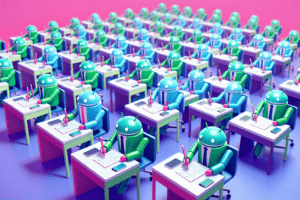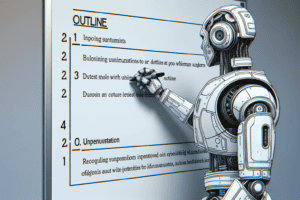Editor’s Note: Brea Weinreb is Community Manager at 99designs, the world’s largest graphic design marketplace. 99designs Pro offers agencies exclusive access to designer recruiting, customized onboarding and training, and tools like white-label services to help agencies scale. Here at Verblio (formerly BlogMutt), we’re working together as a partner to 99designs to make it easier for your agency to connect and work with talented freelancers across a range of creative projects.
If you work for an agency, you intimately know the breadth of work and expertise required to meet your clients’ demands. It can be overwhelming to try to manage all of these things and also think about growing your own business.
Fortunately, there are services and individuals out there that can take some of the production work off of your plate. You already know that this is true for content creation with a capable partner in Verblio. The same goes for graphic design; working with freelance designers can make your workflow more efficient and get your clients better results. In this post, we’ll discuss some of the benefits of working with freelance designers as an agency and offer tips for building a freelance graphic design dream team.
Why Work With Freelance Designers?
Whether you have in-house designers or not, freelancers allow you the flexibility to scale and take on different types of client work.
Efficiency and Flexibility
If you’re trying to grow your business—and who isn’t—outsourcing can help you scale your output and grow your agency faster. This means you can take on more clients and projects without overworking your in-house team. You can also avoid missing deadlines by recruiting additional graphic design freelancers whenever a project gets unwieldy.
Plus, outsourcing allows you to get services to your clients faster. Working with freelancers across the globe means there’s always a designer online to make sure projects get finished on time.

(Deviant Wolf Brewing logo by 99designs designer C1k)
Expertise and inspiration
All freelance designers bring their own aesthetic and perspective to the graphic design table. By outsourcing from project to project, you can filter your search based on the specific perspective or aesthetic your project needs, giving your agency the ability to satisfy a wider range of clients. Let’s say one client wants a vintage logo, and another wants ultra-modern packaging design. Or, let’s say one client wants a set of movie posters for their series of independent films, and another client needs a complete brand identity for their newest tech venture. Outsourcing gives you the ability to work with an expert in each style and design category, rather than relying on one stretched, harried in-house person to be a jack-of-all-trades. Plus, not all designers are the same. The designer who crafts that vintage logo may not be as adept at creating a vintage book cover design, which is why it’s great to have a range of designers and illustrators on hand.

(Deliqu logo by 99designs designer olimpio)
Scalability
You may already have an in-house graphic design team–and that’s great. However, what do you do when one month there’s a huge spike in clients’ needs, and the next month, there’s none? In-house designers are great for the workload that’s consistent and predictable from month to month. But as every agency knows—there is always that unpredictable extra. Rather than over-working your already strapped team or hiring against an unpredictable need, outsourcing projects to freelancers only when you need it takes the stress of workflow management off your plate and consolidates costs.
Focus on what you do best
You run an agency. What you excel at is finding the right solution to your clients’ problems. Design is one service amongst many that your clients turn to you for (content, for another). By outsourcing services like graphic design and copywriting, you’ll be able to focus on the bigger picture and ensure you are meeting and exceeding your client’s expectations.

(Monogram logo by 99designs designer sheva™)
Variety
When you outsource, you can get 10 different brand concepts for your clients from 30 different designers, instead of a mere one to two options from a single designer. Presenting this variety and breadth to clients will show that you have the capacity to go above and beyond expectations. Plus, no one needs to know. You can easily white label designs so clients don’t see that you’re outsourcing.
The Different Types of Outsourcing
There’s more than one way to outsource a design project. You can work directly with a freelance designer or crowdsource your project using a design contest. Here’s how each option works.
Work directly with a designer
Working one-on-one with a designer is recommended for clients who have a good idea about the direction they want their project to go in, or need work done for more complex jobs. For example, if you’re looking for help with a web design project that entails several pages and specific information on each page, it’s best to work one-on-one with a designer to ensure you get all the webpages you need. How much this kind of project costs depends on what you agree upon with your designer.
There are multiple ways to find a freelancer. One of the easiest is to go through a site that specializes in connecting businesses to freelancers, like Upwork, Fiverr or 99designs. All of these sites give you the ability to find graphic designers, but 99designs is the only one tailor-made for design work. 99designs’ Find a Designer tool allows you to filter through their community of designers by style and skill, and find designers that are available, responsive, and who have had success in your design category. Plus, all designers on 99designs are vetted by design experts and are rated by actual customers so you can rest easy knowing you’re filtering by and working with top talent.
Crowdsourcing through contests
You also can crowdsource on a site like 99designs. (Fun fact: Verblio was originally modeled after 99designs’ system, so it may seem familiar!) If you choose to crowdsource, you’ll turn your design project into a contest that designers from around the world can submit ideas to.
You can get just about anything designed this way, including a brand identity, a logo design, product packaging, a poster, you name it. When you launch a crowdsourced contest on a site like 99designs, you choose the best design from all the concepts submitted, and then have the opportunity to continue working with the winning designer to finalize the project. After your contest ends, you can also start a project with your designer to work on additional assets, such as branded social media templates to match your new logo design, or business cards that showcase your new brand identity. Your winning designer should also be the person you turn to if you ever need small tweaks to your original design, so it’s smart to keep them in your rolodex.
The contest model works best for projects that benefit from multiple concepts, ideas and styles, like t-shirt or poster design.
Building Your Freelance Dream Team
To avoid scrambling to hire a freelancer at the last minute for each project and to ensure some consistency across all your designs, it helps to have a vetted pool of freelancers on-hand to help with projects as needed. How do you go about doing this? Follow these few simple steps.
1. Evaluate in-house skills and abilities
First, identify the areas your in-house creative team excels in. Then, consider areas where there’s room to grow. Maybe your agency specializes in web marketing, but your clients always ask you about branding. Instead of referring these clients to someone else, you can meet needs like this “in-house” by utilizing freelance designers.

(Logo design for Hummingbird restaurant by 99designs designer ultrastjarna)
2. Supplement your in-house team as needed
Delegate your high-level tasks including account management, brand guidance, and strategy, to your in-house team whenever possible. This way you can ensure rigor and consistency in message. When high-priority, complex projects come up, these are also good choices to keep internal—or to delegate to trusted, repeat freelancers.
 (Trinity’s Tea branding by 99designs designer Rimposhe)
(Trinity’s Tea branding by 99designs designer Rimposhe)
Projects that demand a high level of creativity, a plethora of ideas, or have flexible deliverables are ideal for outsourcing to freelancers. One-to-one projects which you can supervise in-house without much effort are also perfect for your freelance team. Think marketing materials, infographics, social media graphics, and outreach collateral.
3. Carefully vet freelancers
This should be obvious, but know your freelancers as well as you can before hiring them. The best fit is going to do the best work for your project, so it’s important to tease this out. Start with the portfolios of your prospective freelancers. Refer to your goals and needs as you evaluate them. Go further; look for reliability, communication abilities, and culture-fit. Make sure you know each freelancer’s range of abilities; don’t waste your time and theirs trying to get them to complete projects that really aren’t in their wheelhouse.
Properly vetting designers can take a lot of time–and time is money. Sites like 99designs and Upwork help with the vetting process by rating designers based on their skill, responsiveness, and past work.
Hosting a graphic design contest is an excellent way to find a great designer (or several great designers) since it allows you to see quality and communication skills up front. You can also get in touch with designers who perhaps didn’t win the contest, but impressed you with their style and results.
4. Communicate well
Your freelance team needs all of the information if they’re going to deliver on your project. Give them access to tools—both for design and productivity—and key documentation. Make sure you provide brand guidelines for both your agency and your client’s business—these will be the most effective pieces of documentation for onboarding freelance designers. If you can’t give your freelancers access to the necessary software, you need to find out how to allow them to access what they need to do the job.
Remember, your team is probably working with you remotely. This means working a little harder to ensure you’re communicating well in writing and being aware of time-zone differences. Don’t assume; be certain everyone understands each deliverable and deadline. Make it a practice for you or your Creative Director to share constructive feedback and guidance with freelancers so that expectations are clear.
5. Talk about money before starting
Never start a project without agreeing to payment terms. Discuss this the first time you talk with a freelancer; this way you both know if the match is even possible. Once you’ve agreed on the terms, put it into writing—and include both the price and the scope.
Learn More About Graphic Design
Are you ready to get out there and wrangle up a team of freelance designers—or maybe just explore with an initial project? Schedule a call with an expert from 99designs Pro for Agencies to get started on your graphic design project.



